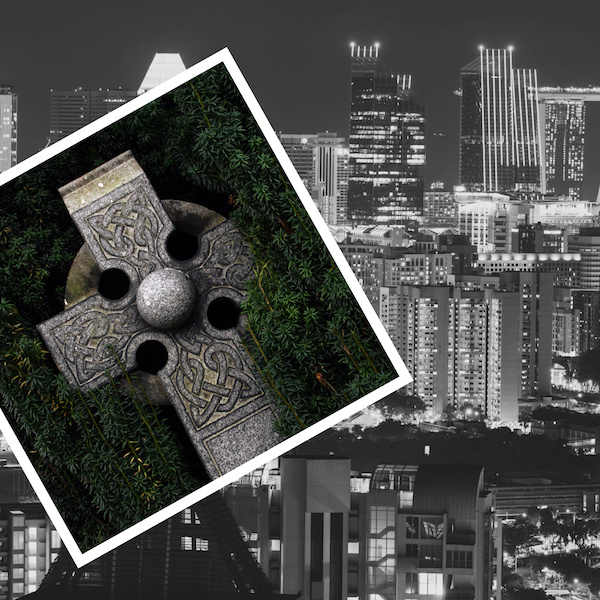Voltaire once noted that God created us in his image . . . and that we returned the favor. Following this logic, we say, “Show us your Jesus, and we’ll show you who you are.” This challenge poses quite a shocking reality check for all of us, for the sad fact is we have made Jesus look a lot more like us than we would care to admit. We have cut Jesus down to size, made and repackaged him into an image of ourselves on a good day and at our best. Now to be fair, it is hard for any of us not to do this to some degree. We all do and will struggle to discover just who Jesus really is. This struggle is, and should be, intrinsic to our discipleship. The fact is, we need Jesus to be like us, for if he isn’t, we doubt whether he can possibly understand who we are and what our human experience is like. An example of this is a crucifix we purchased in Africa which hangs on one of our walls. It portrays Jesus as a black man. All of us have a deep need to know that Jesus identifies fully with us. But to be honest, we can easily overbalance this identification and end up with an image of Jesus that is a far cry from who he really is.
[bctt tweet=”Voltaire once noted that God created us in his image . . . and that we returned the favor. Following this logic, we say, “Show us your Jesus, and we’ll show you who you are.” @alanhirsch ” username=”5qcollective”]Whenever we visit a European city, we usually do three things. Like most Christians, we visit some churches. We also visit, because of our respective backgrounds, the Jewish and the gay areas which, strangely enough, coexist in the same areas of most cities. One of the interesting things we have noted is the contrast between the churches and synagogues. They are strikingly different. The synagogues are usually sparse and unadorned, with absolutely no icons or images; the churches, on the other hand, are usually overly adorned, with icons and images on every wall and altar. It seems to us, historically at least, that Christians have a propensity to create icons and images of God, even though the very creation of an image of God (mental or metal) limits him and can easily become an attempt to control him. The Jewish people seem to have learned the lesson of the second commandment better than us (Exod. 20:4).
On a recent trip to Vienna, we followed our normal pattern, visiting churches et cetera, when we happened across a very big painting of Jesus hanging in the oldest church in Vienna. What struck us about this particular portrait was that Jesus looked strikingly like the average Austrian male, albeit a somewhat more emaciated one (we can’t have Jesus too chubby can we?). The artist made a deliberate and successful attempt to connect his depiction of Jesus with the nationality of the people. Like we said, that is kind of a good thing—he does lovingly identify with Austrians—but image-making comes at a cost. We left the church wondering, What if this Jesus on the cross looked more like the all-too-Jewish carpenter he really was? Would the Austrians in World War II have so eagerly participated in the slaughter of Jewish people in the Holocaust if their Jesus looked more explicitly historical, and therefore Jewish? And if, in this case, he has simply become a purely Aryan Jesus, was this the real Jesus at all or simply an idealization of Austrian religious values—a quasi-religious, nationalist idol?
[bctt tweet=”All of us have a deep need to know that Jesus identifies fully with us. But to be honest, we can easily overbalance this identification and end up with an image of Jesus that is a far cry from who he really is. ” username=”5QCollective”]These are probing questions that should highlight for us the inherent risk in making any image of God and, by extension, Jesus. It seems we often end up with some sort of “Jeebus” who simply affirms our many cultural blind spots and engenders dangerous bigotry. Jesus is reinterpreted in the light of my image and thus becomes a symbolic representation of me/us when we are at our best. We are projecting our self-concern onto God, and it ends in co-opting God to serve our agendas. He becomes a national god, a projection of our collective or individual hopes, a focal point of our narrow concerns, or simply a projection of “me” on a good day. Not a good look! And certainly not worth worshiping.
In ReJesus, Alan and Michael Frost spend a lot of time dealing with this very issue: our need and propensity to create Jesus in our own image. The early chapters of that book are dedicated to freeing Jesus from the stained-glass prisons and domesticated images we have locked him in. A few are pertinent:
- Spooky Jesus: the bloodless alien with an aura and his pumping heart in his hand, which, it should be noted, violates the very meaning of the incarnation—all humanity is bleached out
- Bearded-lady Jesus: portrays Jesus in an overly sentimental and feminine way, kinda like he’s just been done over by the Queer Eye for the Straight Guy gang just before he gets on the cross
- Little baby Jesus: made famous in the movie Talladega Nights, drawn from the harmless stereotype rolled out at Christmastime to make us feel all schmaltzy about our families
- Jesus is my boyfriend: the over-romanticized understanding of Jesus typified in much of the contemporary, touch-me-Lord-type songs we sing
- Jesus the celebrity rock star: typified in Andrew Lloyd Webber’s musical Jesus Christ Superstar, in which Jesus doesn’t quite know what he’s doing, but he loves to sing about it
There are many ways we have re-created Jesus in our own image, and the above parodies are but a few. Even the artistry of icons focuses on an aspect of Jesus and thus limits who he is. Did he really have a blazing aura around his head and assume the hand gestures of a kung fu master? Just a little probing will identify that we all have the capacity to create our own version of Jeebus. In much of our image-making, we have sought to domesticate Jesus and make him a much more manageable lowercase-“l” lord that comfortably legitimates our lifestyle.
Let’s be honest: for many Christians, Jesus has come to look and behave like a nice, regular, high-conformity, somewhat-morally upright/uptight churchgoer. Is this really the wild Messiah we encounter in the Gospels?
Is this the One we love, follow, and seek to be like? Really? Surely not!
It is us who must become like him, not he like us.
Let us know what you think about the post today – which is an excerpt from Untamed, by Alan and Deb Hirsch. It’s amazing and should be in your library and next on your to read list. As we provide glimpses into the purpose of 5Q for the maturing of the Church, we always return to the source: Jesus.
May He be Who He is. Amen!



